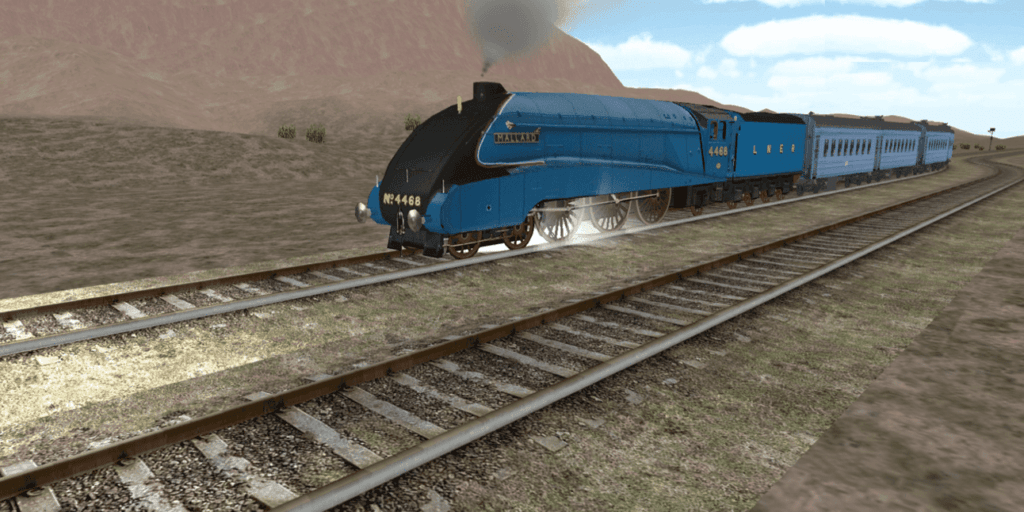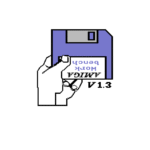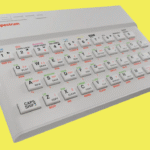If you ever dreamt of driving a steam engine, of raising and lowering pantographs dropping sand on the track or facing the loneliness of a long distance stint in the cab of a train, then Microsoft Train Simulator is for you.
Released in 2001, Microsoft Train Simulator gives the player the sought after opportunity to drive steam, diesel and electric locomotives across routes in Europe, Asia and the United States.
Coupling the technical basics with a realisation of the actual scenery en route, Microsoft Train Simulator does for trains what Flight Simulator does for aircraft.

With realistic sound effects and control mechanisms and task-based journeys, Microsoft Train Simulator is for anyone who never quite got what they wanted from Railroad Tycoon or A Train.
System requirements
Microsoft Train Simulator shipped on 2 CD ROMs and would run on a PC with a minimum CPU speed of 266 MHz with 64 MB RAM, a minimum of 500 MB of HD space, CD-ROM drive, and a 4 MB GFX card. All of that should be accomodated by a standard Windows XP virtual machine, which will also require 1.5 GB of storage for full installation of the game.
As with many retro XP titles, Microsoft Train Simulator benefits greatly from modern system hardware that really lets you get the best out of it.
Playing Microsoft Train Simulator
Control is via keyboard and/or mouse, configurable multifunction input device or by RailDriver, the specialist train sim controller for purists. Here’s a look at that piece of kit in action:
Most users will of course have a keyboard and mouse, and this option is absolutely fine. The tutorial is designed for keyboard and mouse users and proves a useful introduction to Microsoft Train Simulator.
As this is a simulation and not a straightforward game, Microsoft Train Simulator doesn’t really possess the usual difficulty, playability and addictiveness qualities. What it does possess however is a certain magnetism and fascination that will really only count for a potential wannabe train driver – those of you who stare wistfully at viaducts and wander in awe around railway museums.
There are a variety of tracks and routes to choose from, each with its own train. Different trains require a different process to get moving, and it is this variety that lends Microsoft Train Simulator the degree of authenticity that is always required by simulator games.
Various add ons and expansions were available for the game. Rail enthusiasts developed and published compatible maps and routes of some amazing parts of the world. Some of these are now more expensive than the base game.
Graphics
On top-end systems of the time, Microsoft Train Simulator looked good, and over 20 years later, the graphics have weathered well. They’re not perfect or representative of anything contemporary of course, but the scenery – whether the gorgeous Cumbrian countryside in the North of England or the slightly dusty plains of the Asian locations – is evocative of the actual locations.

The design of the various locomotives in the game is good, with a required solidity to the polygon objects racing through the countryside mixed with a more traditional bitmapped interior train control panel.
Sound
With a minimal set of sounds required, there isn’t a lot to be expected from this aspect of the sim. However the various horns and whistles certainly seem authentic, while the general train chugging sound is tailored for each of the engines in the game to be as close as possible as the real world version.
Microsoft Train Simulator’s various outside views showcase both the different view available in the game and the different sounds, and the realisation of the Doppler effect (the change in ton e of a sound as it travels close to the listener, past them and then away into the distance) is well executed.
Microsoft Train Simulator, or Open Rails?
Microsoft Train Simulator: Lined up alongside other train sims, Microsoft Train Simulator has the benefit of a household name and a superb team of developers behind it. Microsoft Train Simulator might not have been the best train simulation around, but it was marvellous fun and a great way to get closer to the dream of driving a locomotive. – Christian Cawley
While Microsoft abandoned the software, your options for play are either a classic virtual machine (for Windows) or Wine (on Linux). Or, you can check out Open Rails, a freeware program compatible with Microsoft Train Simulator.
You can find Microsoft Train Simulator in charity shops/thrift stores, and on eBay.
Affiliate Disclosure: Some of the links in this post may be affiliate links, which means I may earn a small commission if you make a purchase through those links. This comes at no extra cost to you. Thank you for your support!
Christian Cawley is the founder and editor of GamingRetro.co.uk, a website dedicated to classic and retro gaming. With over 20 years of experience writing for technology and gaming publications, he brings considerable expertise and a lifelong passion for interactive entertainment, particularly games from the 8-bit and 16-bit eras.
Christian has written for leading outlets including TechRadar, Computer Weekly, Linux Format, and MakeUseOf, where he also served as Deputy Editor.
When he’s not exploring vintage consoles or retro PCs, Christian enjoys building with LEGO, playing cigar box guitar, and experimenting in the kitchen.









